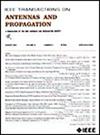Efficiency Analysis of Parasitic Common and Differential Modes for Ultrathin Circularly Polarized Microstrip Antenna
IF 4.6
1区 计算机科学
Q1 ENGINEERING, ELECTRICAL & ELECTRONIC
引用次数: 0
Abstract
This article proposes a comprehensive analysis on the efficiency performance of an ultrathin circularly polarized (CP) microstrip antenna. For ultrathin antennas with intrinsic narrow bandwidth, traditional parasitic-loading methods for bandwidth enhancement encounter significant in-band efficiency reduction, which is named as “efficiency dip,” due to the strong differential coupling between main and parasitic resonators. To address this issue, we propose a feasible structure of parasitic resonator pair. In this case, the common and differential modes (DMs) of the resonator pair are excited simultaneously, with the parasitic common mode (CM) to eliminate the efficiency dip. Inevitably, another efficiency dip appears due to the parasitic DM, but is located out of band without bandwidth deterioration. A prototype is fabricated and tested, showing a CP bandwidth of 3.5% with an extremely low profile of超薄圆极化微带天线寄生共模和差模效率分析
本文对超薄圆极化微带天线的效率性能进行了综合分析。对于固有带宽较窄的超薄天线,由于主谐振器和寄生谐振器之间存在很强的差分耦合,传统的寄生加载方法在带宽增强中会遇到显著的带内效率降低,称为“效率下降”。为了解决这个问题,我们提出了一种可行的寄生谐振器对结构。在这种情况下,谐振器对的共模和差模(dm)同时被激发,寄生共模(CM)消除了效率下降。由于寄生DM,不可避免地会出现另一个效率下降,但位于带外而不会导致带宽恶化。制作并测试了一个原型,显示出3.5%的CP带宽和极低的轮廓$0.012~\lambda _{0}$ ($\lambda _{0}$是中心频率处的自由空间波长)。整个波段的最终效率超过68%。本文为超薄外形、小面积宽带CP天线的设计提供了指导,例如用于移动终端。
本文章由计算机程序翻译,如有差异,请以英文原文为准。
求助全文
约1分钟内获得全文
求助全文
来源期刊
CiteScore
10.40
自引率
28.10%
发文量
968
审稿时长
4.7 months
期刊介绍:
IEEE Transactions on Antennas and Propagation includes theoretical and experimental advances in antennas, including design and development, and in the propagation of electromagnetic waves, including scattering, diffraction, and interaction with continuous media; and applications pertaining to antennas and propagation, such as remote sensing, applied optics, and millimeter and submillimeter wave techniques

 求助内容:
求助内容: 应助结果提醒方式:
应助结果提醒方式:


